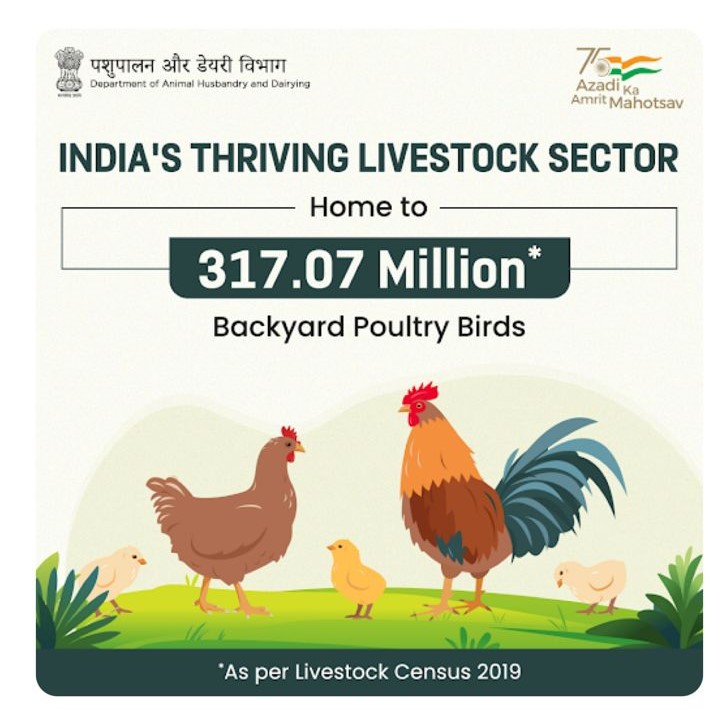Back Yard Poultry Birds in Bird’s eye view
- Back yard poultry population has increased significantly by 45.8% from 2012 to 2019 as for Department of AH, Government of India.
- Backyard poultry birds increased to 317.07 million ,
- The total poultry population in the country is 851.81 million in 2019, registered an increase of 16.8% in the total poultry as for Department of AH, Government of India.
- a) The total birds in the backyard poultry in the country is 317.07 million
- b) Backyard poultry farming is a profitable business among rural and landless families in India.
- It mainly involves low investment and yields high economic returns, and can be easily managed by women, children, and the elderly.
- There is hardly any requirement of infrastructure setup for backyard poultry farming and it can be easily handled by women, aged family members and children.
- In India, four types of backyard poultry farming are practiced, i.e.,
– traditional,
– small-scale rural,
– small-scale intensive,
– and native chicken farming.
9.Major constraints of backyard poultry farming in India are :
– high mortality rate in young chicks due to a combination of diseases,
– lack of infrastructure,
– low production performance of desi birds,
– lack of scientific knowledge,
– predation,
– malnutrition,
– climatic exposure
– and feed price fluctuations throughout year.
10.In order to overcome these constraints:
-there is a need of introducing improved varieties of poultry suitable for backyard farming,
-scientific skill development of farmers on :
-feeding,
-housing
– and disease prevention
– as well as management.
11.Indigenous village chickens (IVCs) greatly contribute to food security and rural development.
Backyard poultry Nutrient requirement:
12.The balanced ration may be formulated with appropriate percentage of maize, rice polish, wheat bran, ground nut cake, fish meal, shell grit or lime stone along with salt, minerals and vitamins or may be with locally available ingredients.
13.The poultry feed should contain at least 20% protein in starter level, 16% in grower and 18% in laying stage with energy level (ME) 2800 kcal/kg feed in starter, 2600 kcal/kg at grower and 2650 kcal/kg in layer ration.
14.Energy and protein requirements of backyard poultry is higher as they are reared as free ranged birds.
15.Considering the above characteristics the breeds that can be recommended for backyard poultry farming are- Gramapriya, Vanaraja, Giriraja, Girirani, Cavery, etc.
16.The annual egg production capacity of Gramapriya and Vanaraja birds are 150 to 180 egg/ bird/ year.
17.First egg lays at 200 to 230 days depending on plane of nutrition and
other management parameters.
18.Egg weight varies from 55 to 60 gram.
19.Mature body weight 2.5 to 3.5 kg.
20.For better health care in backyard poultry farming the birds should be vaccinated against virus diseases in time.
21.The diseases that mostly affect the birds are Ranikhet disease, Marek’s Disease, Fowl pox, Gumbroo disease etc.
22.Regular vaccination schedule may be followed in a poultry farm .
CRD in Poultry challenges in rainy season:
successful preventive and treatment measures.
23.Respiratory infections in chicken and turkeys are seen worldwide but especially in temperate poultry-producing areas in rainy season.
24.CRD is one of the most economicallyimportant diseases of chicken caused by Mycoplasma gallisepticum.
25.The organism mostly colonizes inthe respiratory tract and multiplies in the trachea, lung and air sacs. The incidence of CRD based ongross lesions varied from 9.87-12.84% (Uddin et al., 2010).
26.The report showed that a higher incidenceof CRD was observed in summer followed by winter and rainy season (Yunus et al., 2009)
a) whereasSultana et (2012) and Bahatti et al. (2013) observed higher cases in winter.
The major economiclosses of CRD were mainly due to high morbidity, mortality, carcass condemnation, decreased eggproduction, reduced hatchability rates, altered feed efficiency and weight gain (Gondal et al., 2015;Karthik et al., 2018).
The transmission of CRD disease can be either horizontal or vertical (Hassan et al.,2014).
Diagnosis is made based on history, clinical signs and symptoms, post mortem findings (Karthiket al., 2018).
Dust, ammonia and other gases, and other factors associated with poor ventilation, may act as predisposing factors.
Intercurrent infection with respiratory viruses (IB, ND, ART), virulent E. coli, Pasteurella spp. Haemophilus, and inadequate environmental conditions are predisposing factors for clinical disease.
Some major clinical signs of M. gallisepticum in chickens include those of :
a)respiratory distress such as :
b) coughing,
c) sneezing,
d) slight to marked rales,
e) difficulty breathing.
Other relevant clinical signs of disease:
a) swelling of hocks, shanks
b) and abnormal feathers.
c) Swollen eyelids, ocular discharge, and loss of sight are signs and symptoms that are very important for this disease as well.
M. Synoviae , M. gallisepticum infections can cause significant economic losses on poultry farms from chronic respiratory disease, reduced feed efficiency, decreased growth and decreased eggs.
A widely used molecule in CRD medication programs is tiamulin, a pleuromutilin antibiotic, the combined tiamulin and chlortetracycline resulted in a significant reduction of the severity of clinical respiratory disease post treatment and a significant reduction of the M. gallisepticum numbers in the respiratory tract.
(A Garmyn et al. Poult Sci. 2017.)
Right product to control CRD in your farm.
14.Products like Vetmulin containing Tiamulin hydrogen fumarate:
a) Effective against Mycoplasma gallisepticum and M. Synoviae and other bacterial infections.
b) quick absorption and penetrates target tissue.
c) controls morbidity and mortality due to CRD .
d) enhances activity with Chlortetracycline.
e) No withdrawal period.
Vetmulin like products
Improves:
a) In Breeders : enhances hatchability and chick quality.
b) in Layers: increases egg production .
c) in Broilers: significantly decreases mortality and improves FCR.
16.:Dosage in Breeders, Layers and Broilers.
a) for prevention :15 mg for kg Body weight for 3 to 5 days and repeat once in a month.
b) for treatment: 30 mg for Kg Body weight for 3 to 5 days.
In Broilers , please do not use products like Vetmulin with anti coccidial , ionophores like Salinomycin,Narasin and Monensin.
Dr V. Rajendra Prasad,Poultry consultant








